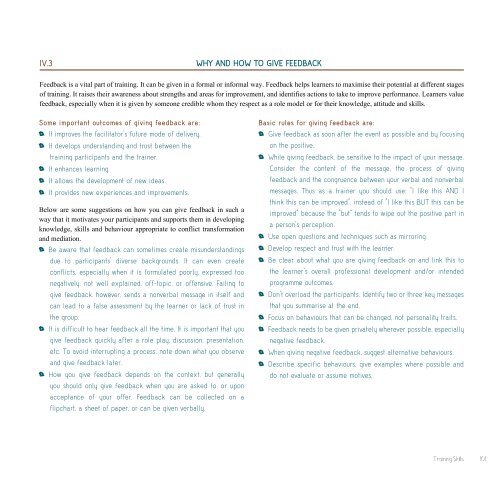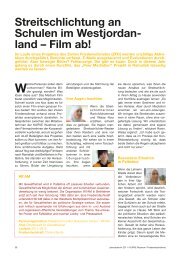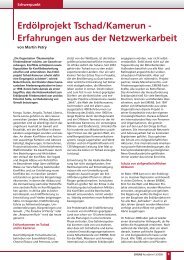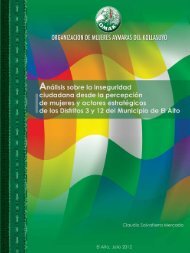Merging Ethiopian Wise-Counsel Mediation and Facilitative ...
Merging Ethiopian Wise-Counsel Mediation and Facilitative ...
Merging Ethiopian Wise-Counsel Mediation and Facilitative ...
- No tags were found...
You also want an ePaper? Increase the reach of your titles
YUMPU automatically turns print PDFs into web optimized ePapers that Google loves.
Iv.3Why <strong>and</strong> how to Give FeedbackFeedback is a vital part of training. It can be given in a formal or informal way. Feedback helps learners to maximise their potential at different stagesof training. It raises their awareness about strengths <strong>and</strong> areas for improvement, <strong>and</strong> identifies actions to take to improve performance. Learners valuefeedback, especially when it is given by someone credible whom they respect as a role model or for their knowledge, attitude <strong>and</strong> skills.Some important outcomes of giving feedback are:> > It improves the facilitator's future mode of delivery.> > It develops underst<strong>and</strong>ing <strong>and</strong> trust between thetraining participants <strong>and</strong> the trainer.> > It enhances learning.> > It allows the development of new ideas.> > It provides new experiences <strong>and</strong> improvements.Below are some suggestions on how you can give feedback in such away that it motivates your participants <strong>and</strong> supports them in developingknowledge, skills <strong>and</strong> behaviour appropriate to conflict transformation<strong>and</strong> mediation.> > Be aware that feedback can sometimes create misunderst<strong>and</strong>ingsdue to participants' diverse backgrounds. It can even createconflicts, especially when it is formulated poorly, expressed toonegatively, not well explained, off-topic, or offensive. Failing togive feedback, however, sends a nonverbal message in itself <strong>and</strong>can lead to a false assessment by the learner or lack of trust inthe group.> > It is difficult to hear feedback all the time. It is important that yougive feedback quickly after a role play, discussion, presentation,etc. To avoid interrupting a process, note down what you observe<strong>and</strong> give feedback later.> > How you give feedback depends on the context, but generallyyou should only give feedback when you are asked to, or uponacceptance of your offer. Feedback can be collected on aflipchart, a sheet of paper, or can be given verbally.Basic rules for giving feedback are:> > Give feedback as soon after the event as possible <strong>and</strong> by focusingon the positive.> > While giving feedback, be sensitive to the impact of your message.Consider the content of the message, the process of givingfeedback <strong>and</strong> the congruence between your verbal <strong>and</strong> nonverbalmessages. Thus as a trainer you should use: "I like this AND Ithink this can be improved",”instead of "I like this BUT this can beimproved" because the "but" tends to wipe out the positive part ina person's perception.> > Use open questions <strong>and</strong> techniques such as mirroring.> > Develop respect <strong>and</strong> trust with the learner.> > Be clear about what you are giving feedback on <strong>and</strong> link this tothe learner's overall professional development <strong>and</strong>/or intendedprogramme outcomes.> > Don't overload the participants.—Identify two or three key messagesthat you summarise at the end.> > Focus on behaviours that can be changed, not personality traits.> > Feedback needs to be given privately wherever possible, especiallynegative feedback.> > When giving negative feedback, suggest alternative behaviours.> > Describe specific behaviours, give examples where possible <strong>and</strong>do not evaluate or assume motives.Training Skills101
















